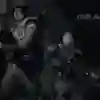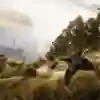Games
We talk to the game director uncovering the bones of this promising pre-historic adventure.
Far Cry Primal releases for PS4, Xbox One and PC on Tuesday 23 February. For more coverage, be sure to read our tips tutorial for how to survive.
Far Cry has never been a series to shy away from the extravagant, to hide behind its no- revered moniker or, simply, to play things safe. From its wide-open worlds to its outlandishly drawn characters and creatures, its myriad of weapons to the near-countless ways in which you can go about tackling the problems it poses its players, this is a series that leaves nothing behind closed doors. Alongside the likes of Grand Theft Auto, Just Cause and Fallout, Far Cry is an open-world game franchise we ceaselessly expect great things from.
With Far Cry 4 having been safely in players' hands for over a year, Ubisoft is finally ready to start talking about the next entry. Far Cry Primal is set to take us back to the Stone Age next year on PC, PS4 and Xbox One, representing the earliest and most exotic setting for a series that has already taken us to African savannahs, Himalayan kingdoms and Pacific island chains.
We recently sat down with the game's director, Thomas Simon, to talk through some of Primal's finer details, understand the decision to travel so far back in time and uncover what that might mean for players.
"The idea of bringing Far Cry into the Stone Age is one that has been running around in the minds of Far Cry developers for quite a while. There was some discussion about it at around the time of Far Cry 3, so when we did start there was already a lot of excitement," reveals Simon with no small degree of animated charm from his overly-cushioned seat within the basement setting of a white-walled London venue. You wouldn’t find Primal’s protagonist Takker relaxing on one of these.
"[Primal's] conception started around the end of Far Cry 4's development. We had a small group of people that came together and pitched an idea that got a super strong reception from the rest of the team, so we started really quickly. The fantasy was really clear and people had already really put a lot of themselves into it. Honestly, it was really amazing how fast it all started. No one really needed much convincing."
Primal's fantasy of placing you in the loincloth of an early man struggling to overcome the dangers of the Stone Age, a time in which humans were far from the top of the food chain, is, in Simon's eyes, not only a "really clear" fantasy: it's the perfect one to blend into the Far Cry model. In turn, that provides him with an incredibly positive mindset when it comes to approaching and defining a design philosophy – adhering to a model of 'can' over 'can't'.
"The way we think about our design for Primal is 'what can we do' and what do we have at our disposal, rather than 'what can't we do'. Even though we might believe that the Stone Age was a moment in time in which man was less evolved, we're not thinking about the game like that. This was really a moment in time in which man made a stand and began to make the world their own."
"It's the end of the Ice Age, so you still have some giant animals that are not afraid of humans, and you have various migrating tribes that are communicating and clashing. These are perfect elements that exist for us to use. I think the key with Far Cry is about exploring an exotic and lawless location, and both of those are here in Primal."
That world is positioned some 12,000 years ago, a patchwork of thick, deep green tree lines, forest floors shadowed by a canopy almost impenetrable to light, steep cliffs carved from the ceaseless aggression of powerful waterfalls and wide rivers that create natural boundaries and landmarks. Given the relatively less-evolved nature of the human cast on show here, settlements are on the slighter end of the scale. Collections of tents and hunting outposts replace the military bases and modern towns of past Far Cry expeditions.
Despite that, however, Simon is adamant that Primal's setting is one of the richest the franchise has yet offered, delivering typically supreme diversity in an original, progressive way.
"We have increased the density of the world, meaning we can put in more animals to create more of those anecdotes between predator and prey, animal and human et cetera. This can give a very surprising effect to the world as it creates a lot of interacting gameplay systems. The world is even more alive than it's ever been [in Far Cry] because of the way these systems interact with other so much."
Playing for only a short time provides ample demonstration of Simon's claims. Animals of various sizes and dangers roam forests and clearing alike, triggering you into a heightened sense of awareness in an attempt to avoid being a tiger or jaguar's dinner. While previous Far Cry releases have included dangerous animals to overcome and/or avoid, Primal takes the frequency and importance of these encounters to a whole new, wild level.
Keeping teeth and claws at bay with a standard Stone Age arsenal of rock-tipped spear, blunt club and homemade bow and arrow is not easy, none of them packing anything like the punch of the AK-47s and M-16s most of us are used to from games of this ilk. In an attempt to even the odds, then, you have the option of taming predatory beasts and using them, effectively, as living weapons to protect you.
Wolves, bears, sabre-toothed tigers and even honey badgers can be deployed at your side, although only one animal can be used at a time. At your command they will set on the offensive against whatever animal or human you select, either ending the target's life or providing enough of a distraction for you to flank around to a better position.
Simon, however, is keen to stress the effort that has gone into making sure these four-legged allies does not undermine the traditional Far Cry balance.
"We've been careful to make sure that the beasts would be efficient and flexible like a weapon, but at the same time make sure that that isn't the only way to play, that it doesn't become the 'win button'."
"There's so much that will really challenge your abilities and how you use your beasts and weapons. The key, of course, is always how smart and skilled the player is and how they match that with how they want to play. The beasts are a cool weapon with lots of diversity, but it's only one weapon. There is also stealth play and long-range weapons to use etc, because we want to keep the 360-degrees of freedom at all times and make sure the player always has a huge bunch of tactical options to choose between."
Across the catalogue of unusual and creative weapons Far Cry has offered, the beasts certainly stand right at the top of the pyramid. Not only do they offer a completely new way of approaching even the most basic of tasks, they present another layer of complication when it comes to how those "anecdotes" Simon mentioned might reveal themselves. As such, it's difficult for the design team to know precisely how their own game might react in certain situations... a reality made more unpredictable given how open the game is to each player's interpretation.
"We know that we're going for a surprising setup with Primal, and that there's an element of risk to doing it, but it's also very refreshing. Even though it's new, though, it retains the Far Cry core in that you have a lot of freedom to explore tactical choices.
"The game could be made easier or more difficult depending on our choices, but taming animals to fight alongside you isn't mandatory. We're going to show you how these things work, then let you explore them however you like, just like we do with every progression system in the game."
"You can go hardcore and never level up at all if you like, trying to go through with two bars of health and trying to stealth everything without relying on your beasts. It's up to you."
Choice and consequence is at the heart of Primal. Using your intelligence to work through problems, rather than simply relying on the game to do the work for you, is key to progression.
Further evidence of this approach is highlighted by the way you go about taming beasts in the first place, the actual mechanics of it made as simple as possible in order to have you more quickly move onto the infinitely more important task of making a decision about how to employ them.
"We focused on making sure the mechanic to tame beasts is very quick and simple. The main goal is not to have a difficult taming mechanic, it's to have players collect all of the beasts," Simon explains.
"As you play, you gain the ability to purchase skills that allow you to tame new categories of predator. That might be the canines like dogs and wolves, felines like jaguars, panthers and tigers or other animals like the bear, sabre-toothed tigers and even bigger things. Once you've purchased the right skill you have to find the animal out in the world and look for an opportunity to get close to it without it attacking you. You can use the bait to help you."
"Once you get close to it in a calm way you can appease it and it will join your beast inventory. If it's inured you can heal it, if it dies you can revive it from the menu using some specific resources. Some animals are more expensive to revive than others, so you need to be careful about managing resources. It's a risk and reward type of system."
Risk and reward, then, empowers everything about Primal. Not only are players expected to take the risks that reap rewards, but the game's designers expect it of themselves, too. Hence, the Stone Age setting and the risk of moving back through time to an era without machines and elaborate military technology.
An old and well-matured environment it might be, but Primal's take on the pre-historic man is anything but geriatric and predictable. It's refreshing to see a franchise harbouring this level of fame not afraid to try something new and push for progress by tackling ideas that others have yet to attempt. 2016 might well turn out to be the year of the mammoth.
For more gaming coverage, follow @RedBullGames on Twitter and like us on Facebook.













